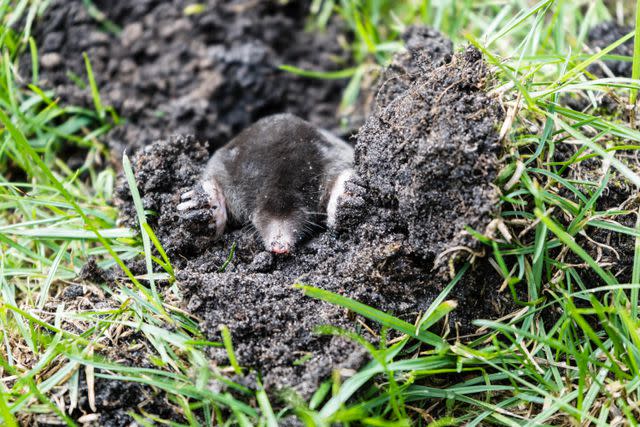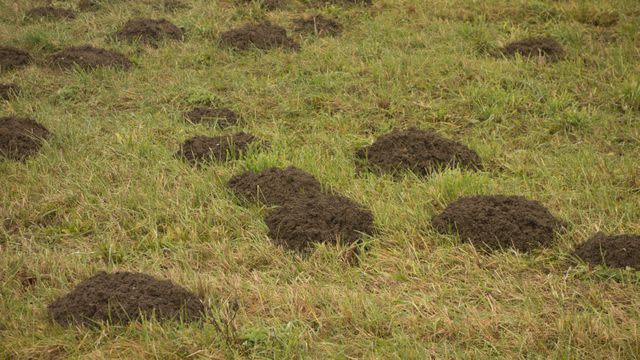How To Get Rid Of Moles In Your Yard, According To Experts
Here’s how to tell if you have moles and what to do about them.
If your yard is riddled with bumps and ridges, you may have some underground neighbors: Moles! These small mammals spend most of their lives underground and are rarely seen. But their expert digging skills leave behind multiple tunnels that mar your lawn and make mowing difficult.
Meet The Experts
Sheldon Owen, PhD, is a wildlife extension specialist at West Virginia University.
Robert Pierce, PhD, is a state extension fisheries and wildlife specialist at the University of Missouri.
Clint Waltz, PhD, is a turfgrass extension specialist at the University of Georgia.
Why do they make such a mess? “Moles are insectivores,” says Sheldon Owen, PhD, wildlife extension specialist at West Virginia University. “They’re tunneling in search of food, pushing the dirt out of their way. They have large, paddle-like front feet that help them burrow, almost like they’re swimming through the soil.”
They’re constantly on the hunt for food because all that tunneling requires a lot of energy. “Moles feed day and night, and burrowing occurs year-round. They do not hibernate,” says Robert Pierce, PhD, state extension fisheries and wildlife specialist at the University of Missouri. “They consume about 80 percent of their weight daily.” Moles eat insects, snail larvae, spiders, and small invertebrates, but their favorite foods are earthworms and white grubs.
While moles don’t carry any known diseases or pose a threat to people or animals, they can create problems if you love a pristine lawn. “Because they dig beneath the soil surface, the roots of grasses may be separated from the soil,” says Clint Waltz, PhD, turfgrass extension specialist at the University of Georgia. “They can sometimes cause turfgrasses to dry out.”

Getty Images / Andreas Steidlinger
Related: 7 Ways To Keep Deer Out Of Your Garden, According To Experts
How To Get Rid of Moles
Unfortunately, there’s no easy, foolproof way to get rid of moles. Mostly, they’re simply a nuisance but not a huge problem. However, if you’re tired of the tunnels and hills, you can try these tips to make your yard less appealing:
Identify the culprit. Make sure it’s a mole—and not a vole—because voles require different management techniques. For voles, use a snap trap baited with peanut butter and covered with a protective cover, such as a piece of cardboard tented over it because they don’t like to feed in the open, says Owen. The cover also prevents birds from accidentally becoming caught.
Exclude moles from key areas, if possible. For example, place a piece of hardware cloth in the bottom of raised beds to prevent tunneling, says Pierce.
Try repellents. There are many on the market, but castor oil is one that has shown minor effectiveness, says Pierce. Follow the label instructions, and reapply as needed. But don’t expect miracles because it’s not infallible.
Apply insecticides, especially grub control, to your lawn. Check with your local university coop extension service (find yours here) to learn the right time to do it in your area. Moles may go somewhere else to eat if you’ve reduced the amount of available food, says Waltz.
Use a trap. The most successful method for mole control is trapping, says Pierce. There are three types of traps: Scissors-style, harpoon style, and a choker loop. Each type must be placed over tunnels where there’s evidence of daily mole activity. Traps can take some trial-and-error and may take multiple attempts because a mole may change its habits.
Forget about sonic devices, scare tactics, and pin-wheel devices. There’s no scientific evidence proving these things work, says Pierce.
Avoid toxic baits. They generally are not recommended because any animal—including cats and dogs—can get into them and be negatively impacted, says Owen. There’s also the risk of secondary toxicity if a mole comes to the surface, dies, and is eaten by raptor or other predator. Even “gummy worm” baits, which are designed to be placed in a tunnel and more closely mimic a mole’s natural food preferences, have risk if children or pets ingest them.
How To Tell If You Have Moles
Moles leave behind distinctive raised ridges of soil that appear above their tunnels, which are 5 inches or more below the ground surface. There will be long, straight travel tunnels (their daily highways), and tunnels that zig zag around, which is where they’re hunting for food. You’ll also see the occasional volcano-like mounds of soil, which are 2 to 12 inches tall. These are the result of moles clearing out excess soil from deeper excavations, says Owen.
Moles prefer soft, sandy soils and tend to avoid heavy or clay soils. While it may seem like you have a lot of moles based on the number of tunnels you see, the truth is that they’re mostly solitary, says Owen. On average, there are 3 moles per acre. However, a mole’s home range is huge (up to 3 acres!) for such a small mammal because they’re voracious eaters.

Getty Images
How To Tell the Difference Between Moles and Voles
Sometimes homeowners mistake mole damage for vole damage, says Pierce. Voles are rodents, which look like field mice with short tails. They dig short, shallow tunnels and burrow right under the surface of snow in winter.
They’re also opportunists and will use established mole tunnels. But unlike moles, voles can be highly destructive to gardens because they’re herbivores that eat ornamentals, vegetables, bulbs, tubers, tree bark (especially on saplings), and roots, says Owen. Voles often are the ones to blame when previously-healthy plantings topple over for no apparent reason or when a tree is girdled around its base from gnawing.
Related: How To Patch Holes In Your Lawn
For more Southern Living news, make sure to sign up for our newsletter!
Read the original article on Southern Living.

